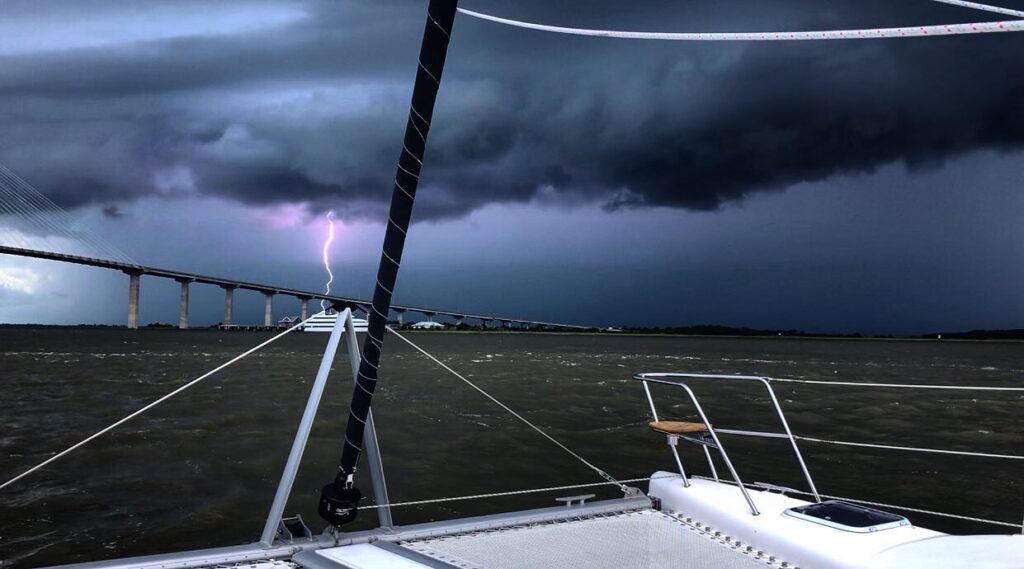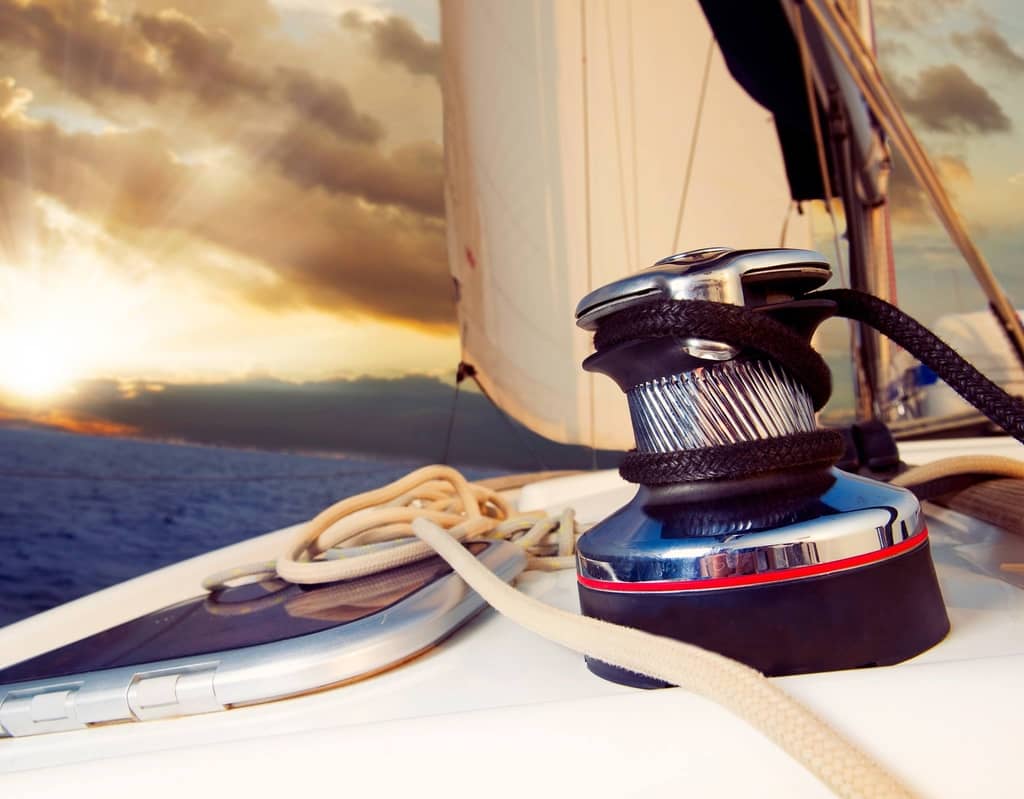Is It Safe to Sail in a Thunderstorm?
As a matter of fact, a mariner’s worst nightmare is thunderstorms. They can form quickly, resulting in hazardous wind and wave conditions. Thunderstorms can bring gusting winds, lightning, waterspouts, and torrential downpours, turning a pleasant day of sailing into a nightmare. If you’re already at sea, lightning strikes, like collisions with whales or floating cargo, can’t be avoided, and thunderstorms are among nature’s most powerful forces. So, in this article, I’m going to examine if it’s dangerous to sail during a thunderstorm. If you want to know more about it, keep reading!
General Info about Thunderstorms
Squall line thunderstorms that have developed over land also occur at sea. Thunderstorms that originate at sea are most common in the early hours of the morning, around sunrise. Tropical thunderstorms, on the other hand, can strike at any time, often on a daily basis. This is because of the strong heating over land and an endless supply of moist tropical air from the sea. Note that a lightning bolt is the result of thunder. Lightning is a powerful current that lasts only a few seconds. In general, bolts of lightning can destroy electrical and navigation systems, vaporize antennas, create holes in the hull, and cause fires.
Although there are no special lightning warnings or advisories, all thunderstorms create lightning. A vessel struck by lightning can be disastrous, especially if it causes a fire or damage to the electronics. It’s advisable to stay in the interior of your boat and avoid touching metal or electrical devices. And, stay as low as possible in the boat if your boat doesn’t have a cabin. When thunderstorms are present, boaters should exercise extreme caution and have a plan of escape. Keep in mind that sailors are particularly vulnerable since they may not be able to reach port on time. It is therefore strongly advised that you do not go outside if thunderstorms are expected.
So, if you’re sailing and notice thunderstorms approaching, get to a port or a safe shelter as soon as possible. Finally, note that planning and training ashore are essential for boating safety. Remember that thunderstorms are usually only a few minutes long, so waiting it out is preferable to riding it out.

>>Also Read: Are Sailboats Safe?
Lightning Protection on a Sailboat
The following system must be installed on your boat to provide lightning protection: A sharp-pointed rod (lightning rod) must be attached to a good conductor of electricity at the boat’s highest point. Note that in case the mast is from metal you can use it. Run a thick copper wire (#8AWG) from the rod or mast to a metal keel. Without any bends, this wire should be straight. Mechanically, all connections must be sturdy. Metal keel plates must be bolted through the hull and have strong electrical contact with the water.
In theory, a properly grounded mast (lightning rod) will provide a protective cone. The rod’s point should extend at least 6 inches above whatever it is protecting. The cone then makes a roughly 60-degree angle with the vertical, with a radius of 1.5 to 2 times the height of the lightning rod at the waterline. If the entire boat is within this cone, the protection will be at least 99 percent of potential strikes. Note that the protection is 99.9% when the temperature is below 45 degrees.
If you’re caught in a thunderstorm, everyone should stay in the middle of the boat. Also, in case you have a microwave, put your hand-held VHF or GPS in there. If not, keep it at least a few feet away from anything metallic. In addition, don’t allow anyone to enter the water. Lastly, note that you shouldn’t touch or approach anything metallic.
How Possible Is It for a Sailboat to Get Hit by a Lightning?
When in the thick of a lightning storm, sailboat masts appear to be hit all the time. However, it is not true that they do. Many times, sailors caught in the middle of a thunderstorm are completely unaffected. At the same time, the water in their immediate vicinity is impacted dozens of times. When you’re sailing on a monohull sailboat, you have a 0.4 percent chance of being hit. And, the bigger the boat, the more lightning is likely to strike. That may not seem like a lot, but it’s still one out of every 1000 boats.
Okay, so the lighting isn’t the main problem. However, if you are hit, you will have serious problems, and it might be extremely dangerous. In case you have to change the position of your boat you can do it. However, make sure you’ve sailed in bad weather and can deal with it before attempting this. Also, have some contingency plans in place in case the worst happens.
Consequences of Lightnings on Sailboats
There’s no need to worry every time there’s any lightning nearby. Although it is possible, impact does not frequently result in fires. It is important to note that each impact is unique. Every time a lightning strike occurs, the intensity of the impact varies. However, in the vast majority of cases, the same thing occurs. To begin with, your rigging may be fried, perhaps completely destroyed. Damages to your electronic equipment are also possible. Moreover, bolts of lightning can remove parts of your wiring which will cause a fire or explosion of the batteries. Lastly, damages on the hull or blowing out thru-hull fittings are also possible.
Even if a lightning strike misses you, if the impact is close enough and powerful enough, damages to your electronics are likely to happen. This is because of the peak voltage and it’s possible to occur even if your devices are off. Furthermore, a full-fledged impact could bring your mast down, but this is quite rare. And, note that damages to your rigging will make it impossible to handle the sails.
During most thunderstorms, sailors are already below decks, seeking shelter from the rain. Lightning is still a concern for ten minutes or more after the rain stops and even when the sun comes out. As the storm approaches, lightning can also pose a risk. Note that the storm could be a long way away and the sky could be clear. And, it’s still feasible that a lightning strike would occur.
Preventing Damages Caused by Thunderstorms
In order to prevent damage to your sailboat caused by bolts of lightning and thunderstorms, you can use a piece of anchor chain to prevent the lightning. Wrap it around the mast like a cap shroud, then drop the end into the water. This causes a form of earth return, which is supposed to keep lightning strikes at bay. Note that an electrical charge dissipator can be installed in the masthead. This will prevent the mast from being dragged down by the impact.
Finding yourself without a means of navigation is one of the most likely and worst things that can happen after an impact. Lightning has the potential to ruin your GPS and even flip your compass. So, consider investing in a battery-powered backup GPS receiver. Note that you have to keep it away from any metal parts. It’s practical because you can use it in order to save waypoints such as the harbor entrance and shallows.
What to Do in a Thunderstorm
In case your batteries are dead and you can’t use your sails, you can start the engine. And, even if the mast and batteries are lost, you should start your engine to ensure that you maintain full control of your sailboat. But, on the other hand, you won’t be able to start your engine in case your batteries are fried. And, the worst-case scenario is if there are strong winds and you can’t use your sails. Also, you won’t be able to maneuver the bow into the wind so as to avoid capsizing. You should reef your sails immediately in the event of strong winds or unpredictably changing conditions. Don’t wait for the storm to really get going. Acting quickly will save you a great deal of time.
Bear in mind that you shouldn’t hold anything made of metal. When securing the boat avoid touching any metal pieces throughout the duration of the storm. This lowers your chances of being hit by an impact. Of course, you should have a fire extinguisher onboard. And, note that it’s safer for anyone to be below deck during a thunderstorm. In the event of an impact, this will be the safest location. Don’t forget that you should unplug all electronic devices. Remove all electronics’ wires and consider putting them in the oven. Many people say that this trick works.
Preparation
It’s possible for lightning to strike up to ten miles away from the cloud that caused it. Keep in mind that just because you’re in the middle of a thunderstorm doesn’t imply you’ll get struck. However, some sailors who were hit reported varying degrees of electrical equipment damage, but no structural or fire damage. Here’s what you should do in order to prepare yourself and your boat in the event of a thunderstorm:
- Turn off all electronics as the storm approaches. Modern devices and equipment have increasingly effective internal protection, but makers still recommend shutting it off.
- Touching metal on the boat, such as shrouds and guardrails, is never a good idea.
- In most cases, the light from a nearby strike will be blinding. So, consider sitting in the cockpit until you regain your night vision.
- Make a fix and write it down on a piece of paper. Use dead reckoning to update your log.
- Masthead units, VHF antennas, and lights are likely to be destroyed, so bring a good quality spare VHF antenna.
- Unplug all masthead components, including wind instruments and VHF antennas, and keep leads separate to prevent arcing.
- Following a strike, fluxgate compasses might lose their calibration. With a portable compass, double-check any electronic compass readings.

>>Also Read: Are Waterspouts Dangerous to Boats?
Storm Strategy
Once you’re in the middle of a thunderstorm, storm strategies can assist you to deal with it. There are a few tried-and-true options for reducing strain and motion by directing one of the boat’s ends (bow or stern) toward the waves. In all conditions, note that no single technique will work well for all boats.
Sailing with a storm jib and a deeply reefed mainsail or storm trysail is preferable. This method gives you the most control. In the waves, sails provide you the ability to turn and control your boat. Run ahead of the storm, with the stern facing the waves and perhaps a drogue to slow the boat down. Keep in mind that this tactic necessitates a large amount of sea room and active steering of the boat.
Another risk is that you would stay in front of an approaching storm instead of sailing away from it. So, what you can do on a narrow reach, is to heave-to with the jib trimmed to windward. Heaving-to is a good heavy-weather strategy, however certain boats perform better than others. While hove-to or beneath bare poles, deploy a sea anchor. A sea anchor is a miniature parachute attached to the bow by a line. A sea anchor keeps the bow of the boat up into the waves, preventing the boat from becoming beam to the seas.
Note that the load on the rudder when the boat is pushed aft is another source of concern. Another option is to lie ahull, or simply sit with the sails down. Because you lose control of your angle to the waves and may wind up beam to the ocean, this passive option is less reliable than the other techniques. Furthermore, without the assistance of sails, the motion of the boat rolling in the waves can be debilitating.
Facts about Thunderstorms
- It is a myth that a lightning never strikes the same spot twice. Several strokes of lightning can strike the same location in fast succession in a typical lightning strike. The fact that tall structures are sometimes attacked multiple times every year proves this.
- It is also a myth that there is no risk of being struck by lightning if it is not raining. Lightning bolts can strike up to 10 miles outside of the main storm’s rain area, and they do so often. According to new data on lightning deaths, the majority of deaths occur when the storm appears to be finishing.
- When compared to hurricanes and winter storms, thunderstorms only affect a small area. A typical thunderstorm has a diameter of 15 miles and lasts about 30 minutes. Around the planet, around 1,800 thunderstorms are active at any given time. That’s a total of 16 million every year!
- Thunderstorms are all harmful, no matter how tiny they are. Lightning is produced by every thunderstorm, and it kills more people each year than tornadoes. Some thunderstorms can also bring with them strong winds, hail, and tornadoes.
- If you’re onshore and lightning is approaching, you should lie down flat on the ground. In that situation, the best thing to do is crouch down, which means putting your feet together, squatting low, and tucking your head. Lightning creates electric currents along the ground’s surface that can travel over 100 feet and be lethal. While lying flat keeps you low, it also increases your chances of being impacted by ground currents. You want to be as low as possible while only touching a little portion of the ground. Getting indoors to adequate shelter would obviously be preferable.
- Thunderstorms are most common during the spring and summer months, and in the afternoon and evening hours, but they can happen at any time of day or night. Thunder and lightning can even occur during a snowfall!
- The National Weather Service issues a severe thunderstorm watch when the weather conditions indicate that a severe thunderstorm is likely to form. Winds of at least 58 miles per hour or hail at least three-fourths of an inch in diameter define a severe thunderstorm. When a severe thunderstorm is spotted or indicated by weather radar, a severe thunderstorm warning is issued.

>>Also Read: Is Sailing Dangerous?
Is It Dangerous to Sail in a Thunderstorm? – The Bottom Line
In general, it is dangerous to sail during a thunderstorm. Lightning strikes, on the other hand, are unusual. Unpredictable changes in wind direction and surprise wind gusts are the most dangerous aspects of thunderstorms for sailors. It is generally advised to avoid sailing during storms if at all feasible. As you may know, there are a lot of myths surrounding sailboat masts and electrical storms.
Of course, the true question is whether or not you can set sail when thunderstorms are expected. The basic answer is yes, but I would avoid it if at all possible. The more honest response is that it is entirely up to you. But, once again, I would suggest caution. The likelihood of being struck isn’t as high as most people imagine. Most people believe that in case they get caught in a thunderstorm the complete catastrophe will happen. But, that’s not the case. The most dangerous aspect of the storm is the unpredictable wind that comes with it. Most thunderstorms are accompanied by abrupt shifts in wind direction and speed. In some circumstances, the wind changes direction 180 degrees on a regular basis. It can result in extremely violent gybes, breaking the mainsail, or potentially causing mast damage.
